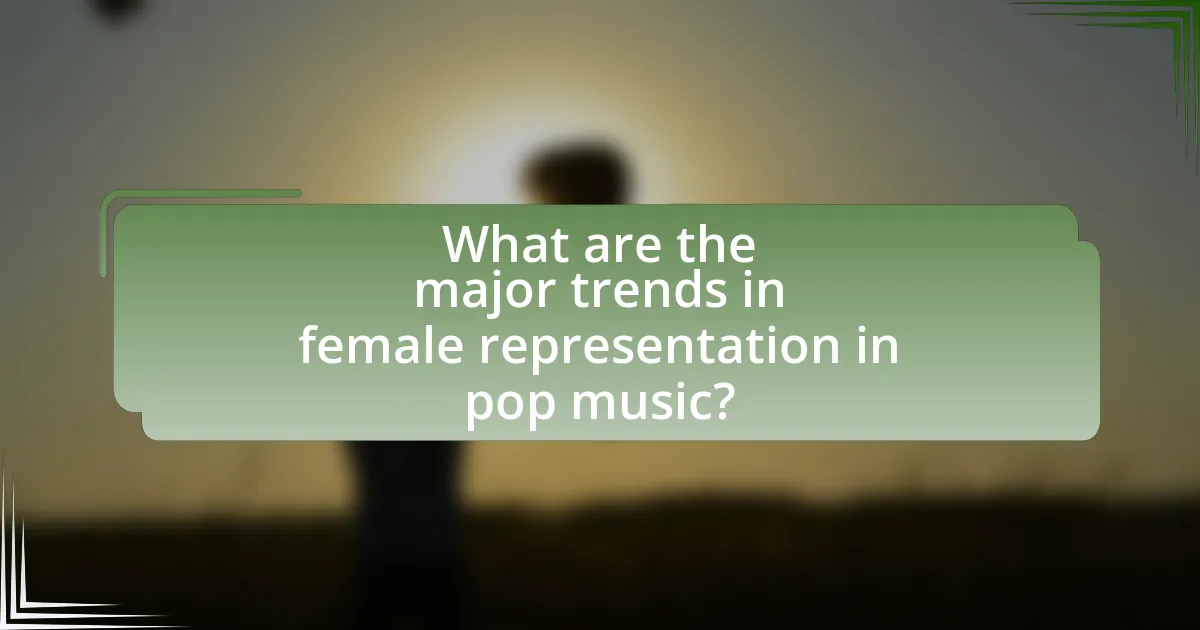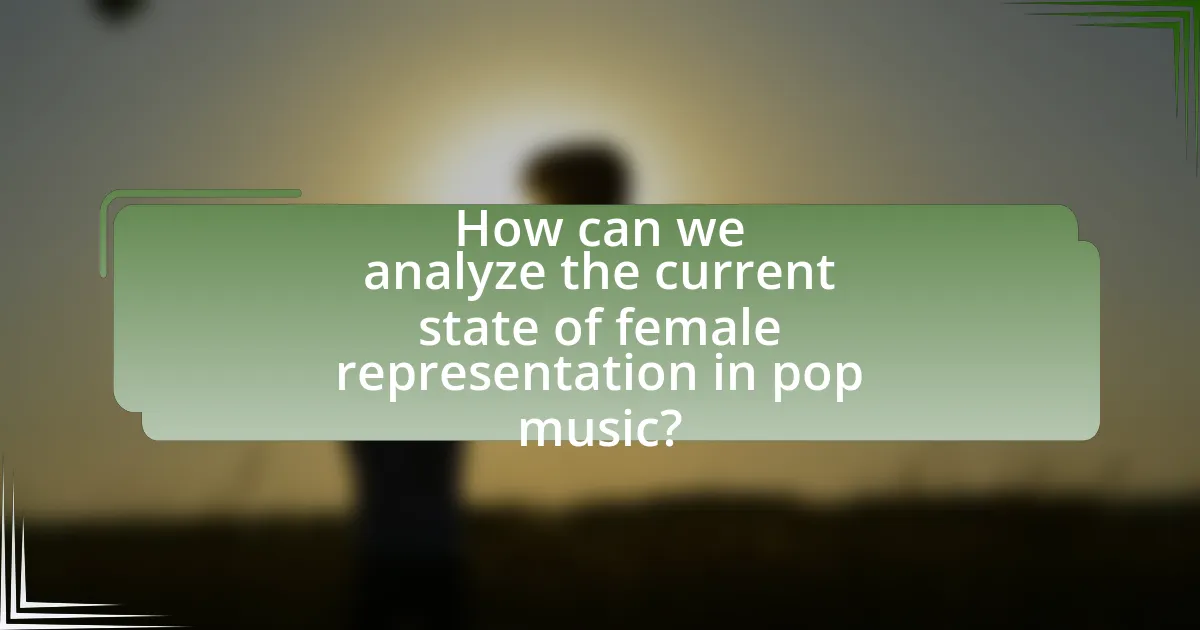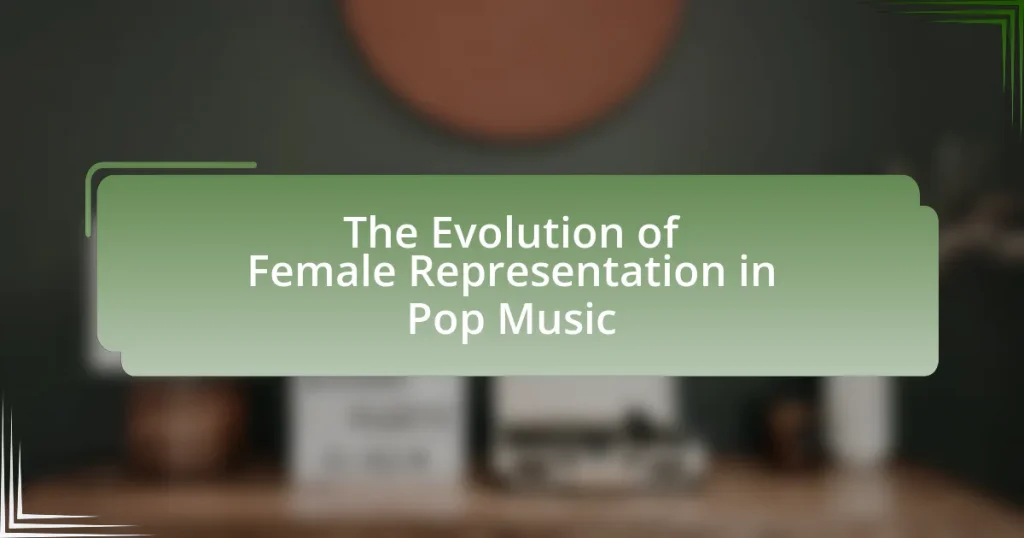The article examines the evolution of female representation in pop music, highlighting the transition from objectification and limited roles in the 1950s and 1960s to empowerment and diverse narratives in contemporary music. It outlines key milestones, such as the emergence of influential artists like Aretha Franklin, Madonna, and Beyoncé, who challenged societal norms and redefined femininity in the industry. The article also discusses the impact of societal changes, the importance of female representation, and the ongoing challenges faced by women in the music industry, including gender bias and limited opportunities. Additionally, it analyzes current statistics on female artists, initiatives aimed at improving representation, and the role of fans in supporting emerging female talent.

What is the Evolution of Female Representation in Pop Music?
The evolution of female representation in pop music has transitioned from objectification and limited roles to empowerment and diverse narratives. In the 1950s and 1960s, female artists like Brenda Lee and The Supremes were often portrayed in traditional roles, focusing on romance and domesticity. By the 1980s and 1990s, artists such as Madonna and Whitney Houston began to challenge these norms, asserting their independence and sexual agency, which was reflected in their music and public personas.
In the 2000s, the rise of artists like Beyoncé and Lady Gaga further expanded female representation, emphasizing themes of empowerment, self-expression, and social issues. Research by the Annenberg Inclusion Initiative in 2020 highlighted that women comprised only 21.6% of artists in the top charts, indicating ongoing challenges despite progress. However, the increasing visibility of female artists in various genres and their roles as producers and songwriters demonstrate a significant shift towards greater representation and influence in the industry.
How has female representation in pop music changed over the decades?
Female representation in pop music has significantly evolved from the 1950s to the present day, transitioning from a focus on traditional roles to a more diverse and empowered presence. In the 1950s and 1960s, female artists were often portrayed in stereotypical roles, primarily as vocalists who adhered to the expectations of the male-dominated music industry. By the 1970s and 1980s, artists like Madonna and Tina Turner began to challenge these norms, asserting their independence and sexual agency, which paved the way for future generations.
The 1990s and 2000s saw an increase in female artists who not only dominated the charts but also took control of their music and image, exemplified by figures like Britney Spears and Beyoncé. Recent years have further expanded this representation, with artists such as Billie Eilish and Lizzo embracing authenticity and body positivity, reflecting a broader cultural shift towards inclusivity. Statistics show that in 2020, women made up 27.6% of artists on the Billboard Hot 100, a notable increase from previous decades, indicating a growing presence and influence in the genre.
What were the key milestones in the representation of women in pop music?
Key milestones in the representation of women in pop music include the emergence of female artists in the 1960s, such as Aretha Franklin and Janis Joplin, who challenged gender norms and showcased women’s vocal power and emotional depth. The 1980s saw the rise of pop icons like Madonna, who not only dominated the charts but also redefined female sexuality and autonomy in the music industry. In the 1990s, artists like Britney Spears and TLC brought mainstream attention to diverse representations of femininity, while the 2000s introduced a wave of female empowerment anthems from artists like Beyoncé and Lady Gaga, emphasizing independence and self-expression. These milestones reflect a progressive shift in the portrayal of women, moving from objectification to empowerment and agency in pop music.
How did societal changes influence female representation in pop music?
Societal changes significantly influenced female representation in pop music by shifting cultural norms and expectations regarding gender roles. The feminist movements of the 1960s and 1970s, for instance, challenged traditional portrayals of women, leading to more empowered and diverse female artists in the music industry. This shift is evidenced by the emergence of artists like Aretha Franklin and Joan Jett, who not only showcased their musical talents but also advocated for women’s rights and autonomy. Additionally, the rise of social media in the 2000s further democratized the music landscape, allowing female artists to gain visibility and connect directly with audiences, thereby enhancing their representation and influence in pop music.
Why is female representation important in the pop music industry?
Female representation is important in the pop music industry because it fosters diversity, empowers women, and influences cultural norms. Diverse representation allows for a wider range of perspectives and experiences to be shared, enriching the music landscape. Empowering women in pop music encourages future generations to pursue careers in the industry, as seen with artists like Beyoncé and Taylor Swift, who have broken barriers and set new standards. Furthermore, studies show that female artists often address social issues, contributing to discussions on gender equality and women’s rights, thereby shaping societal attitudes. For instance, a report by the Annenberg Inclusion Initiative found that only 22.5% of artists on the Billboard Hot 100 were women in 2019, highlighting the need for increased representation to reflect the actual demographics of society.
What impact does female representation have on audience perception?
Female representation significantly influences audience perception by shaping societal norms and expectations regarding gender roles. Research indicates that when women are prominently featured in pop music, it can lead to increased acceptance of diverse female identities and empower listeners, particularly young women, to embrace their individuality. For instance, a study published in the Journal of Popular Music Studies found that female artists who challenge traditional stereotypes positively affect listeners’ attitudes towards gender equality. This demonstrates that female representation not only alters perceptions of women in music but also contributes to broader cultural shifts in how gender is viewed in society.
How does female representation affect the careers of female artists?
Female representation significantly enhances the careers of female artists by increasing visibility and opportunities within the music industry. When female artists are prominently featured in media, award shows, and playlists, it leads to greater recognition and commercial success. For instance, a study by the Annenberg Inclusion Initiative found that women comprised only 21.6% of artists in popular music from 2012 to 2019, indicating a lack of representation that directly correlates with limited career advancement for female musicians. Conversely, initiatives promoting female artists, such as the #MeToo movement and various female-focused music festivals, have resulted in increased sales and streaming numbers for women in music, demonstrating that enhanced representation can lead to tangible career benefits.

What are the major trends in female representation in pop music?
Major trends in female representation in pop music include increased visibility, diversity in genres, and empowerment themes. Over the past two decades, female artists have gained significant prominence in the pop music landscape, with statistics showing that women accounted for 52% of the Billboard Hot 100 chart entries in 2020, reflecting a shift towards greater representation. Additionally, artists like Beyoncé, Taylor Swift, and Lizzo have embraced diverse musical styles, breaking traditional genre boundaries and appealing to a wider audience. Empowerment themes are prevalent in lyrics, with songs addressing issues such as body positivity, independence, and social justice, exemplified by tracks like “Run the World (Girls)” by Beyoncé and “Truth Hurts” by Lizzo. These trends indicate a transformative period in pop music, where female artists are not only more visible but also influential in shaping cultural narratives.
How have different genres of pop music influenced female representation?
Different genres of pop music have significantly influenced female representation by shaping societal perceptions and expectations of women. For instance, the rise of girl groups in the 1960s, such as The Supremes, showcased women as empowered figures in the music industry, promoting themes of independence and strength. In contrast, the emergence of the “bad girl” persona in the 1990s, exemplified by artists like Britney Spears and Christina Aguilera, often emphasized sexuality and youth, reflecting and sometimes reinforcing societal stereotypes. Additionally, the genre of hip-hop has introduced a complex narrative around female artists, with figures like Nicki Minaj and Cardi B challenging traditional gender roles while also facing criticism for their portrayals of femininity. These shifts illustrate how pop music genres not only mirror cultural attitudes but also actively shape the discourse around female identity and empowerment in society.
What role do sub-genres play in shaping female artists’ identities?
Sub-genres play a significant role in shaping female artists’ identities by providing distinct platforms for expression and audience engagement. Each sub-genre, such as pop, rock, hip-hop, or country, offers unique cultural narratives and stylistic conventions that influence how female artists present themselves and their music. For instance, female artists in hip-hop often confront and challenge societal norms regarding femininity and empowerment, as seen with artists like Nicki Minaj and Cardi B, who utilize their sub-genre to assert their identities and agency. Additionally, the sub-genre of country music has historically allowed artists like Dolly Parton and Kacey Musgraves to explore themes of personal struggle and resilience, thus shaping their public personas. This interaction between sub-genres and female artists’ identities illustrates how musical categorization can empower women to navigate and redefine their roles within the music industry.
How do collaborations between male and female artists affect representation?
Collaborations between male and female artists enhance representation by promoting gender diversity and challenging traditional gender roles in the music industry. These partnerships often lead to increased visibility for female artists, as they share the spotlight with male counterparts, thereby normalizing female presence in genres historically dominated by men. For instance, the collaboration between Shakira and Rihanna on “Can’t Remember to Forget You” not only showcased both artists’ talents but also highlighted the importance of female collaboration in mainstream music, contributing to a broader acceptance of women in various musical styles. Furthermore, studies indicate that such collaborations can lead to a more balanced portrayal of gender in media, as they often result in songs that address themes of equality and empowerment, thus influencing public perception and cultural narratives surrounding gender roles in music.
What challenges do female artists face in the pop music industry?
Female artists in the pop music industry face significant challenges, including gender bias, limited representation in decision-making roles, and societal expectations regarding their image and behavior. Gender bias manifests in unequal opportunities for promotion and airplay, as studies show that male artists receive more radio play than their female counterparts. Additionally, women are often underrepresented in executive positions within record labels and music management, which affects their ability to influence industry standards and practices. Societal expectations impose pressure on female artists to conform to specific aesthetics and behaviors, often prioritizing appearance over musical talent. These challenges hinder their career advancement and creative expression, as evidenced by research from the Annenberg Inclusion Initiative, which highlights the disparities in gender representation in the music industry.
How do stereotypes impact the success of female pop artists?
Stereotypes significantly hinder the success of female pop artists by limiting their artistic expression and marketability. Female artists often face societal expectations regarding their appearance, behavior, and musical style, which can restrict their creative freedom and lead to typecasting. For instance, a study published in the Journal of Popular Music Studies found that female artists are frequently judged more harshly than their male counterparts based on their looks rather than their musical talent, impacting their opportunities for promotion and airplay. This bias can result in fewer resources allocated to female artists, ultimately affecting their commercial success and visibility in the industry.
What barriers exist for female artists in gaining recognition and support?
Barriers for female artists in gaining recognition and support include systemic gender bias, lack of access to industry networks, and underrepresentation in decision-making roles. Systemic gender bias manifests in the form of stereotypes that question women’s artistic credibility and leadership abilities, often leading to fewer opportunities for female artists compared to their male counterparts. Research by the Annenberg Inclusion Initiative found that only 21.7% of artists in popular music are women, highlighting the significant gender disparity in the industry. Additionally, female artists often face challenges in accessing industry networks that are crucial for career advancement, as these networks have historically been male-dominated. Furthermore, women are underrepresented in key decision-making roles within record labels and music festivals, which limits their influence over the promotion and support of female talent.

How can we analyze the current state of female representation in pop music?
To analyze the current state of female representation in pop music, one can examine metrics such as chart performance, the number of female artists in leading roles, and the themes present in their music. Recent data from the 2022 Billboard Year-End charts indicates that female artists accounted for approximately 40% of the top 100 songs, reflecting a significant presence. Additionally, studies like the 2021 USC Annenberg Inclusion Initiative report highlight that only 22.5% of popular songs featured female songwriters, suggesting a disparity in creative roles. This analysis can be further enriched by exploring the diversity of female artists across genres and their representation in music videos and award nominations, providing a comprehensive view of their current standing in the industry.
What are the current statistics on female artists in pop music?
As of 2023, female artists represent approximately 30% of the Billboard Hot 100 chart entries. This statistic highlights a significant presence of women in pop music, although it remains lower than their male counterparts. According to a report by the Annenberg Inclusion Initiative, female artists accounted for only 21.6% of all artists on the Billboard Hot 100 from 2012 to 2021, indicating a gradual increase in representation over the years. Furthermore, in 2022, women made up 40% of the top 10 songs on the Billboard Hot 100, showcasing a notable shift towards greater visibility and success in the genre.
How do these statistics compare to previous decades?
Female representation in pop music has significantly increased in recent decades compared to previous decades. For instance, a study by the Annenberg Inclusion Initiative found that the percentage of women in popular music rose from 17% in 2012 to 30% in 2020. This contrasts sharply with the 1980s and 1990s, where female artists often comprised less than 10% of the Billboard Hot 100 chart. Additionally, the 2021 report indicated that women of color represented 23.5% of artists, a notable increase from earlier decades when their presence was minimal. These statistics illustrate a clear upward trend in female representation in the pop music industry over the years.
What are the implications of these statistics for the future of female representation?
The implications of these statistics for the future of female representation in pop music indicate a potential for increased visibility and influence of female artists. As data shows that female artists have been gaining a larger share of chart placements and streaming numbers, this trend suggests a shift in industry dynamics that may lead to more opportunities for women in music. For instance, a report from the Recording Industry Association of America (RIAA) highlights that female artists accounted for 41% of the total music consumption in 2022, up from 36% in 2019. This growth reflects changing audience preferences and could encourage record labels to invest more in female talent, ultimately fostering a more equitable representation in the industry.
What initiatives are being taken to improve female representation in pop music?
Initiatives to improve female representation in pop music include industry programs aimed at increasing the visibility and opportunities for female artists. Organizations like Women in Music advocate for gender equality through mentorship programs, networking events, and educational workshops that empower women in the music industry. Additionally, record labels are implementing diversity quotas and funding initiatives specifically for female artists, as seen in the 2021 initiative by the UK’s Music Industry Trusts Award, which allocated funds to support women in music. These efforts are supported by research indicating that female representation in music leads to broader audience engagement and financial success for the industry.
How are organizations and movements advocating for female artists?
Organizations and movements advocate for female artists by promoting gender equality, providing platforms for visibility, and offering resources for professional development. Initiatives like the Women’s Audio Mission focus on training women in audio engineering, while organizations such as She Is The Music work to increase the number of women in music industry roles. Additionally, movements like #MeToo have raised awareness about gender-based discrimination, leading to increased support for female artists. These efforts are evidenced by statistics showing a rise in female representation in music festivals and industry leadership roles, highlighting the impact of advocacy on the visibility and success of female artists.
What role do music festivals and awards play in promoting female representation?
Music festivals and awards play a crucial role in promoting female representation by providing platforms for female artists to showcase their talent and gain visibility. These events often feature female headliners and nominees, which can challenge gender stereotypes and inspire a new generation of female musicians. For instance, the 2020 Coachella festival made headlines for its diverse lineup, including prominent female acts like Billie Eilish and Ariana Grande, highlighting the importance of female representation in mainstream music. Additionally, awards such as the Grammys have increasingly recognized female artists, with statistics showing that female nominees in major categories have risen significantly over the past decade, thereby validating their contributions to the industry.
What can listeners do to support female representation in pop music?
Listeners can support female representation in pop music by actively seeking out and promoting female artists. By streaming, purchasing, and sharing music from female musicians, listeners can help increase their visibility and success in a male-dominated industry. Research indicates that female artists receive significantly less airplay and promotion compared to their male counterparts, with a 2020 study by the Annenberg Inclusion Initiative revealing that only 21.6% of artists on the Billboard Hot 100 were women. Therefore, listeners’ engagement with female artists can directly influence their opportunities and representation in the music industry.
How can fans influence the music industry to promote female artists?
Fans can influence the music industry to promote female artists by actively supporting their music through streaming, purchasing albums, and attending concerts. This direct financial support increases the visibility and commercial viability of female artists, encouraging record labels to invest more in their promotion. For instance, the success of female artists like Billie Eilish and Lizzo can be attributed to strong fan engagement, which has led to significant chart performance and award recognition. According to a 2020 report by the Annenberg Inclusion Initiative, female artists received only 21.6% of all charted songs in the past decade, highlighting the need for fan-driven advocacy to shift industry dynamics. By utilizing social media platforms to amplify female artists’ work and advocating for their inclusion in playlists and radio rotations, fans can create a more equitable music landscape.
What are some ways to discover and support emerging female pop artists?
To discover and support emerging female pop artists, one can utilize music streaming platforms that feature curated playlists highlighting new talent, such as Spotify’s “Fresh Finds” or Apple Music’s “New Music Daily.” Engaging with social media platforms like Instagram and TikTok allows fans to follow and promote these artists directly, as many emerging musicians use these channels for exposure. Attending live performances, whether in local venues or virtual concerts, provides direct support and helps build a community around these artists. Additionally, purchasing music and merchandise directly from the artists’ websites ensures that a larger portion of the revenue goes to them. According to a 2021 report by the Annenberg Inclusion Initiative, female artists still face significant barriers in the music industry, making grassroots support crucial for their success.




